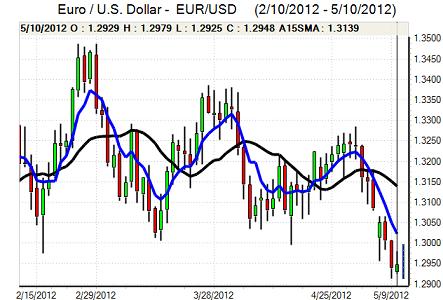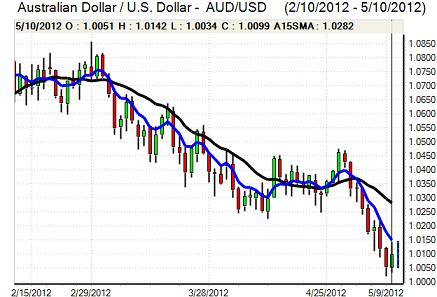EUR/USD
The Euro was confined to narrower ranges during Thursday as markets lacked the energy to break major technical levels, especially with no major fresh incentives, while underlying Euro sentiment was still weak.
After failing to form a government, the SYRIZA coalition handed the baton over to Pasok who came third in the election. There were some rumours of a coalition deal with Democratic Left which had some impact in lifting market sentiment, although there was no evidence of a deal and caution certainly prevailed. There was some relief over a small decline in Spanish bond yields, but banking fears continued.
SYRIZA stated that there was no support for the loan agreement as it was now invalid following the election and there was further speculation that new elections would have to be held. There was still the fundamental obstacle that Greece wants to stay in the Euro, but not maintain the austerity programme. Actions of the German government and IMF will continue to be watched very closely in the short term given the critical impact on Greece and the Euro-zone as a whole.
The latest US jobless claims recorded a slight decline to 367,000 in the latest week from 368,000 previously which maintained some degree of relief surrounding US labour-market trends. The latest US trade account recorded a sharp increase in the deficit to US$51.8bn from a revised US$45.4bn previously as imports rose sharply. There will be optimism that consumer spending remains firm, but the impact of the deficit is likely to trigger a downward revision to US first-quarter GDP estimates.
Fed Chairman Bernanke did not make any significant comments on monetary policy in comments on Thursday and was generally cautious surrounding the growth outlook. The Euro was unable to break above the 1.2970 area against the dollar and consolidated in the 1.2950 region as it attempted the first daily gain for nine sessions. The currency was unable to sustain the gains and weakened back towards 1.29 in Asia on Friday as underlying risk appetite dipped again.

Source: VantagePoint Intermarket Analysis Software
Call now and you will be provided with FREE recent forecasts
that are up to 86% accurate* 800-732-5407
If you would rather have the recent forecasts sent to you, please go here
Yen
The dollar found support in the 79.60 area against the yen during Thursday and pushed towards the 80 level in US trading. There was some relief surrounding the latest US jobless claims data which helped underpin the US currency. There was further caution over yen buying given the risk of intervention and a slight improvement in Wall Street sentiment also had an impact in curbing yen demand.
The dollar was unable to break above the 80 level and retreated back towards 79.80 as an underlying deterioration in risk appetite curbed any selling pressure on the yen as regional equity markets remained on the defensive. The announcement of substantial derivatives trading losses by JP Morgan also provided a net boost to the yen.
Sterling
Sterling dipped weaker in early Europe on Thursday, primarily due to caution ahead of the Bank of England MPC policy meeting. Technical considerations remained important with an important option barrier at 0.80 and failure to break through this level triggered some profit taking on Sterling positions as the UK currency retreated to the 1.61 area against the dollar.
The latest manufacturing data recorded a rebound of 0.9% for March following a revised 1.1% decline previously while the wider industrial production data registered a 0.3% decline.
As expected the Bank of England left interest rates on hold at 0.50% at the latest policy meeting while quantitative easing was also held steady at GBP325bn. There had been some speculation that the MPC could expand the amount of bond purchases given that the current programme has been completed and the decision to hold policy boosted Sterling demand.
The latest NIESR GDP growth estimate remained very subdued with a reading of 0.1% for April following a revised 0.2% decline the previous month. There was still evidence of defensive Sterling demand which helped cushion the currency from losses.
Swiss franc
The dollar was unable to break above the 0.93 level against the franc on Thursday and dipped back towards 0.9260, although ranges were very narrow. As has been the case throughout May, the Euro was trapped very close to 1.2010 with no significant move higher.
Continuing economic and political stresses surrounding the Euro-zone continued to discourage any capital flows out of the Swiss currency and there were further expectations that the National Bank was being forced to intervene to prevent further Euro losses.

Source: VantagePoint Intermarket Analysis Software
Call now and you will be provided with FREE recent forecasts
that are up to 86% accurate* 800-732-5407
If you would rather have the recent forecasts sent to you, please go here
Australian dollar
The Australian dollar found support on dips towards 1.0080 against the US currency during Thursday and attempted to build on the recovery from 2012 lows. The currency failed to gain any momentum and retreated back to below 1.01 later in the US session.
Trading losses as JP Morgan undermined confidence and there were further concerns surrounding the growth outlook which curbed any enthusiasm for the Australian currency. The latest Chinese industrial and retail data was weaker than expected which pushed the Australian dollar back to near the 1.0050 level.



